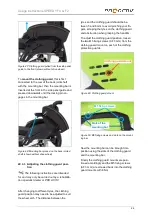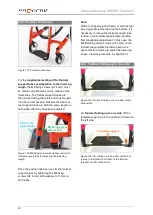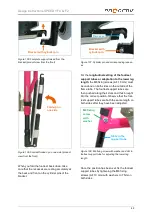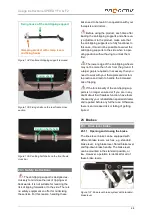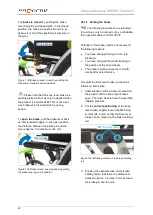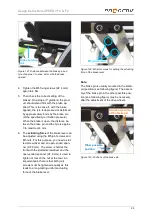
Usage instructions SPEEDY F4 and F2
35
cal. This increases the caster length and
the tendency to vibrate reduces.
Figure 90: Increased caster length via the inclination
of the caster wheel axle
22.3 Replacing the caster forks
A distinction needs to be made between the
caster forks with a screwed axle and those with
a quick-release axle.
In addition, the replacement of the caster
wheel forks with screw-on axles differs from
the angle-adjustable caster-wheel bearing
blocks and welded caster-wheel bearing
blocks.
22.3.1 Caster fork with screw-on axle on
angle-adjustable caster-wheel bear-
ing blocks
The following instructions are intended
for and may only be carried out by a rehabilita-
tion specialist dealer or PRO ACTIV
To
remove the caster fork
with screw-on
axle, the aluminium cap on the caster wheel
bearing block must first be removed. In order
to release the cap, you can run under the cap
using a commercially available cutter knife and
lift slightly at several points. Then the M12 nut
(AF 19 mm) is loosened using, e.g. an AF
19 mm socket. Now the caster wheel for rotary
axle can be pulled out from under the caster
wheel bearing block.
Figure 91: Aluminium cap
Figure 92: Aluminium cap removed and M12 nut
visible
To
assembly the caster fork
with screw-on
axle, this is inserted with the caster wheel axle
into the caster wheel bearing block. Then the
M12 nut (AF 19 mm) is tightened again to
3 Nm and secured with thread lock fluid. Then
the aluminium cap is pressed back onto the
caster wheel bearing block.
For the rotary axle to run smoothly, the M12
nut must not be tightened to more than 3 Nm.
In case more sluggishness is desired, this can
be achieved using a higher tightening torque.
M12 nut
Aluminium cap
Increased caster length
Wheel contact
point
Caster wheel for rotary axle tilted
maximum in the direction of travel
Max.
4 mm




